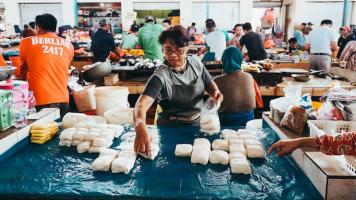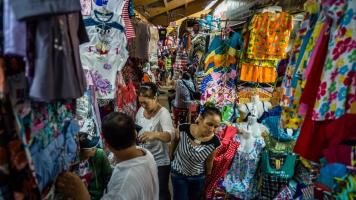
To survive COVID-19, businesses should review their business plans weekly. Photo credit: iStock/pondsaksit.
To stay afloat, SMEs should look at alternative sources of credit, review business plans, and jump online.
When the novel coronavirus pandemic struck, John Carlo Tria faced a trial by fire as the new president of the Davao City Chamber of Commerce and Industry. Elected in December, Tria only had a month under his belt as the chamber’s top executive when the first confirmed case of the coronavirus disease (COVID-19) was reported in the Philippines in January.
He realized he had a huge problem on his hands when he saw how measures introduced to prevent the spread of COVID-19 were affecting businesses, particularly small- and medium-sized enterprises (SMEs). Not only did Tria have to steer his own businesses through the crisis, he had the chamber’s 400-plus members to worry about, too.
Lost year
“Our assessment is 2020 is a lost year. It’s not something you can recover from,” Tria said of the pandemic and the prevention measures that forced businesses to halt operations.
SMEs in Malaysia are in the same boat. Foo Ngee Kee, founding president of the SME Association of Sabah, warned that many SMEs in the state are in danger of going under. “We are mostly bleeding because we were not allowed to operate,” he said. “Many will go down.”
SMEs, which account for more than 90% of businesses in BIMP-EAGA and across Asia, face a higher risk of going under compared to larger enterprises because their cash reserves and other resources are more limited. And with SMEs providing more than two-thirds of jobs in Asia and contributing 30% to 60% to their countries’ gross domestic product, governments are scrambling for ways to help these businesses weather the crisis.
Knowing what is at stake, both Foo and Tria are working to find means to give their respective members a fighting chance against COVID-19.
Here are some ways SMEs can stay afloat amid the pandemic.
1. Consider alternative sources of credit
Financing continues to be among the biggest hurdles facing SMEs in Asia as they often have problems securing bank credit due to strict bank requirements, poor financial record keeping, and lack of collateral.
A 2019 paper from the Asian Development Bank Institute said “fintech” solutions—financing from nonbank sources—may be able to fill the financing gap for SMEs. These include online platforms, such as peer-to-peer lenders, loan-based crowdfunders, or marketplace lenders.
Borrowing from cooperatives may also be an option. Tria said the Davao City business chamber is looking at tapping cooperatives to provide financing to SMEs. “Cooperatives have a lot of cash and they are not covered by the Bangko Sentral… so they have more money to release to SMEs.” The central bank restricts the total loans banks lend to customers to manage money supply and control inflation.
Tria and Foo said SMEs cannot depend solely on government support as state aid is limited. They both urged businesses though to take advantage of all support available to them from the government.
2. Constantly review and update business plans
Businesses need to review their plans and update them as necessary given the situation.
Francisco “Jay” Bernardo III, an entrepreneur and professor at the Master in Entrepreneurship Program of the Ateneo Graduate School of Business in Manila, said business plans should be reviewed weekly as the situation is fluid.
The plans should address concerns about employees’ well-being, keeping customers, maintaining the supply chain, and ensuring a positive cash flow. “When you talk about a crisis like this, when you don’t know how long it will end…the thing to do is do a lot of scenario building. You have to create plans for different scenarios.”
Bernardo said even during lockdown, business owners should constantly keep in touch with their employees, customers, and suppliers to check their situation so they could plan for all potential problems that could arise once they resume operations.
3. Embrace the web
Tria, Foo, and Bernardo said SMEs should explore e-commerce as a way to continue operations during lockdowns or even after lockdowns are lifted.
Before the outbreak, studies already show increased opportunities from e-commerce. A 2018 report from Google and Temasek projected that Southeast Asia’s internet economy could grow to $240 billion by 2025 from $72 billion in 2018.
Foo said some businesses in Sabah have already started to use the web to sell their products in the wake of COVID-19. Before the pandemic, he noted some business owners resisted bringing their business online. “But COVID-19 is slowly knocking some sense into some people used to the traditional economy.”
He said SMEs should also explore Google, Facebook, and other online platforms to market their products and services. They should also watch out for webinars targeted toward businesses to pick up pointers on how to navigate through COVID-19.
Tria said he himself had to digitally migrate the training side of his environmental management business, Environmental Counselors, Inc., because of the social distancing and lockdown measures implemented by the government. He pointed out that going online could mean lower expenses for businesses in terms of utilities, like water and electricity, as they do not have to maintain an office during the lockdown.
4. Innovate
Tria also stressed the importance of innovation to stay in business, drive recovery, and build resilience. Innovation could be in the way business owners find new markets, engage in new business, or embrace online platforms. “The objective really is to find ways to sustain your business all throughout this pandemic and after.”
He expressed confidence on the ability of entrepreneurs to be flexible and to be open to innovations. “Being from Mindanao, flexibility is already part of our business DNA, because we have to deal with a lot of uncertainties. Even before COVID-19, we were used to dealing with uncertainties, threats of violence, and insurgency. So, compared with entrepreneurs from other areas, we’re a bit used to having to deal with threats.”
5. Plan for the ‘new normal’
“Even when the lockdown is lifted, it’s not going to be the same. There is a new normal,” said Foo.
Tria agreed. “Now businesses have to embark on a new path because they have to operate under new conditions, more difficult ones.”
Because of the economic blow from the pandemic, businesses are expected to see weaker demand for their services and products even after the lockdowns and community quarantines are lifted.
Businesses also have to plan for the prolonged impact of COVID-19.
Tria said restaurant businesses, for instance, would have to take into account social distancing in planning seating arrangements in their establishments. “When you open your dining hall, social distancing will force you to take in a limited number of patrons at a time. How do you work around that? That’s the challenge.”
This article was first published by BIMP-EAGA on 22 May 2020.

BIMP-EAGA
The Brunei Darussalam–Indonesia–Malaysia–Philippines East ASEAN Growth Area, or BIMP-EAGA, is a cooperation initiative established in 1994 to spur development in remote and less developed areas in the four participating Southeast Asian countries.


